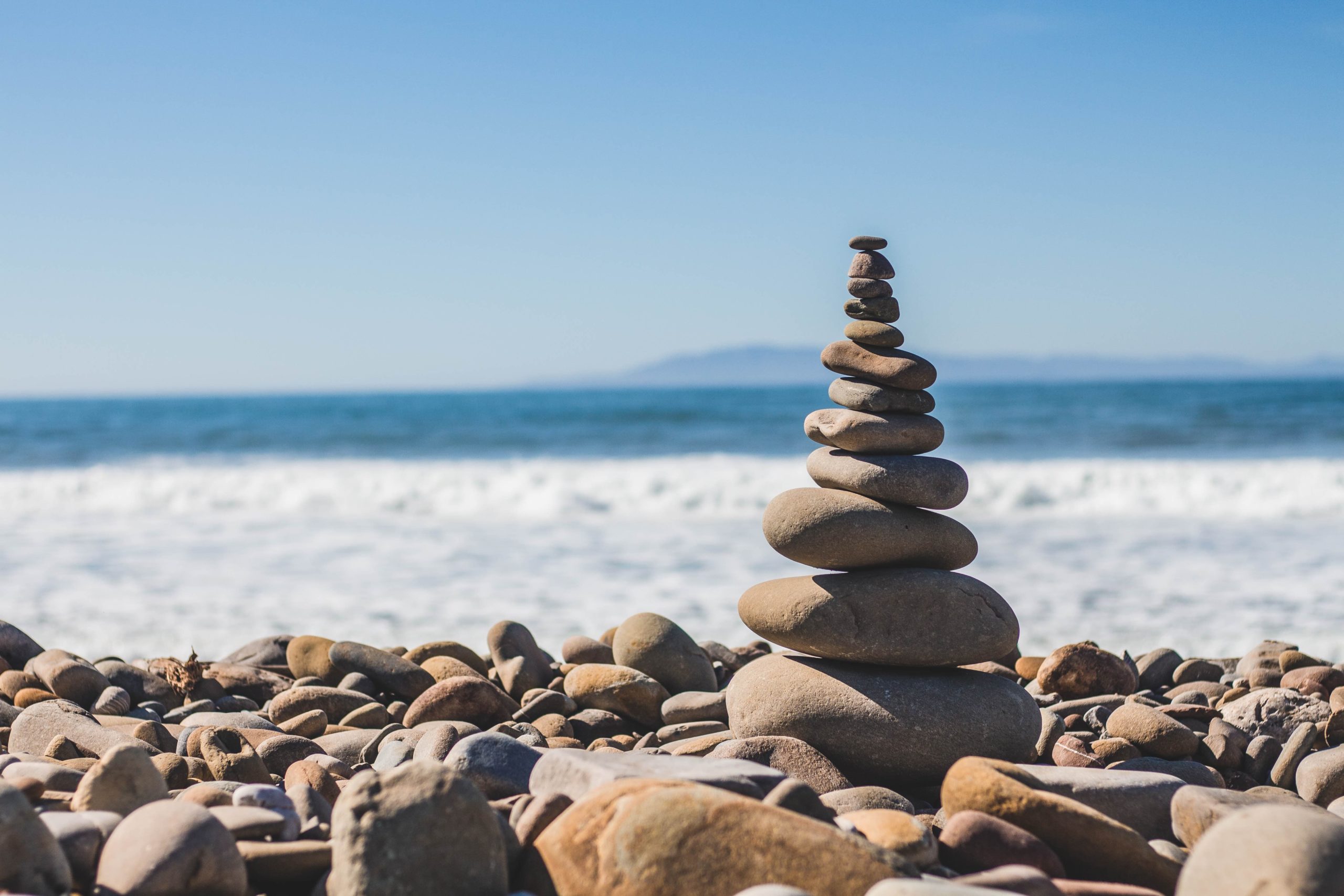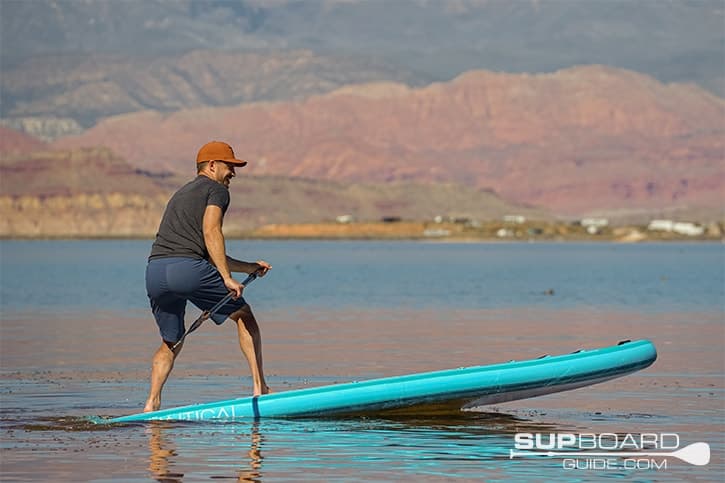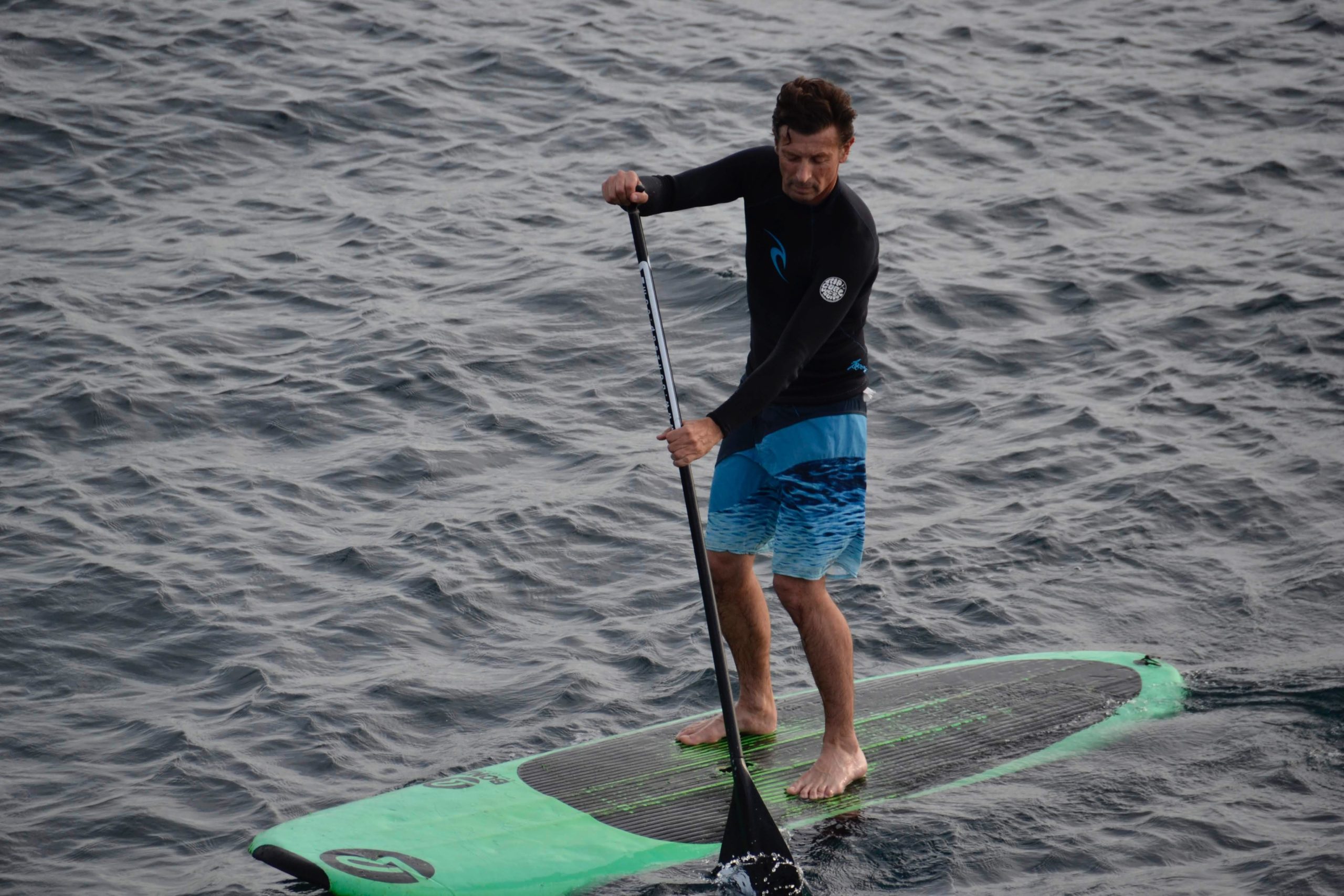One of the most important factors to consider when it comes to paddleboards is stability, especially for those with little to no experience stand up paddleboarding. The stability of the paddleboard is going to have the greatest impact on how easy it is to stand up on, which will also impact how quickly you can gain experience as a SUPer. The more experience you have, the more confidence you’ll have paddling, and the less overall stability you’ll need in a board. So, those new to the sport should look for more stable boards, while those with experience will be fine on less stable ones.
But how do you determine the stability of a paddleboard? While it’s generally true that the larger a paddleboard is, the more stable it will be, there are major reasons why that isn’t always the case. As such, we’re here to help break down the major things you need to know about paddleboard stability to help you make the best, most informed decision when you’re out shopping for your next SUP.

Quick Tip: Understanding Recommended Weight Capacity:
When you’re looking at a paddleboard, the best place to start off will be the recommended weight capacity. Generally speaking, the larger the recommended weight capacity of a particular board, the more stable the board should be compared to others with a smaller recommended weight capacity.
However, the recommended weight capacity does not have a uniform measuring system yet in the paddleboard industry. Some companies list the recommended weight capacity for single paddlers, while some companies list the overall recommended weight capacity. Some companies only list the recommended weight capacity for beginners, while others will list the recommended weight capacity of intermediate to advanced paddlers. This is why the recommended weight capacity is helpful, but not a precise measurement to guess at the stability.
However, whatever the measurement used by the paddleboard company, here are some general guidelines for the base level of performance you can expect.
Recommended Weight Capacity Base Performance Guide:
- 150 – 225 range: Good for teenagers and lighter adults who are 6’ tall or shorter. Experienced adults may still struggle
- 225 – 300 range: Good for all beginner solo paddlers. Experienced paddlers can bring kids or a pet.
- 300 – 375 range: Beginners can go out with kids or a pet. Experienced paddlers can go out with another experienced adult.
- 375+ range: Beginners can go out with another adult for tandem paddling.
With our base performance guide, you’ll have a pretty good idea of the overall stability and beginner friendliness of any paddleboard you are considering purchasing. However, to truly understand the stability of a paddleboard, you’ll want to consider the individual design factors of the board. Some of the most important features and factors to consider include:
Top Factors/Features that Affect SUP Board Stability:
Width. Width will have the single largest impact on the stability of the board. The wider the board is, the more stable it will be in the water. As most paddleboards narrow at the tail and nose, you’ll want to focus on the width of the midsection, where you will be standing when you paddle. Beginners should look for boards that are at least 30’’ wide, with taller or heavier paddlers who are brand new to the sport best suited by 32’’ wide boards and wider.
Nose/Tail Shape. Typically, paddleboards will either have a more pointed, narrow nose and tail or a fatter and wider shape. The fatter, wider, and soft curved planing shape will generally be more stable in most water environments, but can actually cause stability issues when you’re paddling against waves. If you’re taking a paddleboard out to surf or in white water, you’ll want the more narrow, hard curved displacement type board for the most stable experience as this shape will allow for you to cut through the waves and chop.
Length. The length of a board is important, but not as important as the width when it comes to overall stability. A longer board will always be more stable than a shorter board, but only if they have the same width. A board that is too long can also be tricky to maneuver or handle, and may cause stability problems for those learning how to paddleboard. If you are new to paddleboarding, try to stick with an all-around length, which is between the 9’6’’ to 11’6’’ range.
Board weight. Many paddlers believe that the heavier the board is, the more stable it will be in the water. This is not true, though the board’s weight does impact paddleboarding in various water settings. Too light of a board, and you will sink into the water if you overload it. If your board is too heavy, you’ll struggle too much trying to paddle and maneuver the extra weight that it may result in you falling a few more times if not careful. Lighter boards also suffer from major performance loss in windy environments or in large chop, while heavy boards don’t perform well in fast moving water. Finding a board that is neither too light or heavy for a particular water environment is a good balance to find.

Board Construction. Related to the weight of the board is how the board was made. Hardboards typically use a foam EPS core with layers of fiberglass and epoxy reinforcement. Inflatable paddleboards typically use a drop-stitch core with layers of polyester and PVC reinforcement. The more layers of PVC a paddleboard has, the more stable it typically will be, though too many layers will weigh down the board too much and make it too difficult to handle for younger and shorter paddlers. What is actually included in each individual layer of a paddleboard varies from company to company, so there are some SUPs with dual-layers that are better built than some triple or even quad-layered boards. Be sure to read up on the construction methods of a particular paddleboard manufacturer for the best understanding of board construction.
Rail Construction. As a general rule, the more firm and rigid a paddleboard is, the more stable and better overall feel it will have while paddleboarding. To improve paddleboard rigidity without excessively weighing it down, many paddleboards have made rail improvements on top of the base construction. Some paddleboards use removable metal rods, some have integrated carbon fiber rails, while fiberglass, bamboo, or even reinforced taping are other methods to improve the rails of the board. Pay special attention to boards that have some sort of rail system improvement if you want a more stable board that is still beginner friendly and doesn’t weigh too much.
Inflatable or Hardboard. If you buy the right board shape and size, both inflatables and hardboards can be very stable and capable of supporting multiple adult paddlers. Due to how they’re built there, an inflatable that is the same size as a hardboard will be able to support more weight and typically be more stable. However, inflatable paddleboards will suffer a greater performance loss in moderate chop and wind compared to hardboards of the same shape. If you are unsure of whether to go with an inflatable or hardboard, we’d recommend making your choice based on factors other than stability.
Fins. Fins won’t have a huge impact on the stability of your paddleboard, but if you want to maximize your overall stability there are three ways fins can improve it. First, stiffer fins will improve the stability of the board, though it will also make the board harder to turn. Second, moving your center fin to the back of the fin box will improve stability the most compared to all other fin positions. Finally, putting on side fins and using them in conjunction with a center fin will also enhance the overall stability of the board.
Thickness. We saved this for last because thickness is one of the more tricky factors to explain, in part because how it impacts the stability of the board varies by person to person. A board with a lower thickness will cause you to paddle closer to the water, the lower center of gravity giving you more control over the board. However, thinner boards have less overall volume, decreasing the total recommended weight capacity, limiting the true total weight you can load the board with. Furthermore, some paddlers just don’t feel comfortable paddling so low to the water, which will also impact how comfortable and stable you feel on the board. For solo paddlers, we don’t think you have to worry too much about thickness, though for those who want to bring out extra passengers definitely consider going with a thicker board.

Conclusion. The recommended weight capacity of a paddleboard is a great and simple place to start, and will give a good idea of whether the board is stable for you 90% of the time. However, we also test the most trustworthy and popular paddleboards on the market for stability, so that we can give you a more accurate idea of how they actually perform in the water. If you find a board you want to buy but want to know more about its overall stability, be sure to read our reviews here SUPBoardGuide.com for an in depth breakdown of its stability and overall performance.
If you have any more questions about the stability of a paddleboard or want to hear our recommendations, be sure to leave a comment below or send us an email. Otherwise, thank you so much for reading, and we hope you have a great time paddle boarding!
SupBoardGuide
Latest posts by SupBoardGuide (see all)
- Best Paddle Boards for Beginners, 2025 - July 3, 2025
- Hala Radito Whitewater iSUP Review – 2025 - June 27, 2025
- Hala Atcha 96 Whitewater iSUP Review – 2025 - June 16, 2025






I really appreciate the information provided in regard to paddle boards.
We are looking into buying one or two without breaking the bank.
I have been reading about the Isle paddle board company out of San Diego.
Is this a reputable company? Good quality?
We would be using it on a small lake in Wisconsin. Just to have fun and exercise.
Other recommendations?
Catherine,
Yes, Isle is a very reputable company. However, if you’re looking for an option that is cheaper then I’d recommend the Nautical from iRocker, or the Gili Air from Gili. Those will both be a little cheaper than the Isle and are both still great quality. You can see our list of best cheap SUPs here.
If you have a little more to spend, then check out our top rate inflatable SUPs for 2020 – this list will show you all the ones we are currently recommending.
Let me know if you have any other questions!
I am looking for my first SUP, having always been a kayaker but now wishing to experience the greater overall (core strength) and other benefits offered by SUP. I live on an island off the coast of Maine, so would be paddling in open ocean on calm days or in protected bays and coves. If I want to go far or fast, I will use my 18′ sea kayak; the SUP is to get out on the water easily and comfortably. I don’t particularly like swimming in the cold Atlantic, so stability is important, and also light weight to carry to put-ins. I know from kayaking very light boats however, that they can get knocked around a good bit in chop or wind, so am trying to find a happy medium for carrying/paddling weight and stability. I am 5′-2″, 107 pounds, and will always be paddling solo with just a little gear such as lunch, extra clothes, etc. What would you recommend as a good boat for me? I would like to stay under $700.00. Thanks so much for your great advice and reviews.
Hi Linda, I would point you to the Nautical 11’6. This SUP is still light enough (22 lbs) to be easy to carry into and out of the water, but isn’t quite light enough to get bullied by the conditions. It’s also super stable, even for our product reviewers that are a little heavier/taller than you, so it’ll feel plenty solid even when you bring along some extra clothes or food. Added bonus is that it’s on sale right now for $400.
Hi,
I purchased the Retrospec weekender plus. Its 30 inches wide, 10′ long, max weight 300 pounds. I am 5’8, 220 lbs. i have paddle boarded a few times before but never on an inflatable. i never felt this unstable before. I should have gotten a wider board I think. It was calm water and I couldn’t stay on the board for more than a minute or two and I felt unstable and shaky the entire time. I am trying to return the board to get a more stable board, but i have to pay shipping fees and they are saying it may be subject to a 50% restocking fee if it was used. I only used it once. They asked for a picture of the board to see if it would be subject to restocking. Is it possible i just need practice on standing up, foot placement, etc. My legs were shaking the entire time trying to balance. Do you know anything about Retrospec boards?
Hi David,
It sounds to me like you need a wider/longer board. At your height and weight, the 10’x 30″ retrospec just won’t have enough volume for you to feel totally stable. Not being entirely sure what your budget is, we’d recommend you look into boards like the iROCKER 11′ All-Around, Gili Meno, and BOTE HD Aero. In general though, most beginning paddlers feel comfortable on boards that are 32″ wide or more (some smaller paddlers feel okay at 30″), and being 5’8″, you’d feel better on board that are 10’6 or longer.
I had a quick question. I am deciding between an Earth River SUP SKylake 10-9 or an Earth River SUP Dual Layer 10-9. Both boards are the same length and width. The only difference seems to be the Dual board is made of a more durable PVC construction and weighs about 3-5lbs more. I am going o be using the board for fishing and paddling on rivers and open lakes. I don’t use all the fishing mounts and like a more minimal approach. Would you recommend either board, and why? I am leaning toward teh lighter board, but love to hear what you think.
Thnaks,
Sean
Hi Sean,
That’s a tough one, for sure. We’ve only been able to try the ERS Skylake 10’7, but we really liked its performance overall. I think the main difference between the two would be stiffness, as the dual-layer construction should make the SUP more rigid, though it’s hard for us to say for sure without testing both back to back.
Hi . I was thinking of making my own board. Im 66 years old and have some experience on inflatable sups. Im 185 lbs . I would like to have the shortest board possible for transport reasons. Do you think a board 8″ long 34″ wide wth fairly butt ends would work ?
Frank,
What a cool undertaking! 8′ long may be a little short, but that ultimately depends on your height.
I’m 5′-9 in height . My thinking is the width 34″ x 6″ deep would make it stable . I know it won’t be fast but its just for leisurely paddle on a lake
At your height, I would aim for about 9′ long. Otherwise you won’t get a lot of longitudinal stability and you’ll feel unstable when you reach forward to paddle. Even at 5’2″, I sometimes struggle with 8′ SUPs. They’re great for surfing, but not ideal for flatwater paddling on a lake.